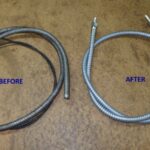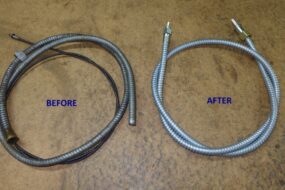On a cable-operated clutch the adjustment is made at the cable end. The clearance is usually measured either at the operating lever or at the pedal.
To work efficiently, the clutch needs the right amount of play in the linkage between the foot pedal and the clutch operating lever (also known as the release arm or fork).
Anything less than the correct amount o free play (or clearance) will result in clutch slip, because the pressure plate will be unable to exert its full pressure on the friction plate.
Failure to cure this fault will quickly lead to a burned-out friction plate, and possibly a ruined pressure plate.
If, however, there is too much clearance in the clutch linkage, the car tends to creep forwards when in gear with the clutch pedal fully depressed.
This is known as clutch drag, and it can cause difficulties in heavy traffic.
It is generally better, however to have too much play in the clutch linkage than too little.
The linkage should be checked and, if necessary, adjusted about every 6,000 miles or 10,000km, or as specified in the maker’s service schedule. Wear on the friction plate and on the linkage will eventually alter the maker’s setting.
Most modern cars have a diaphragm-spring clutch operated either mechanically or hydraulically.
On most cars, mechanical clutch-linkage clearance is measured and adjusted underneath the car. On some the makers advise checking free play a specific measurement between pedal positions – at the pedal, although adjustment may be made underneath
On some cars – many Hondas and Toyotas, for example – checking and adjustment can be done at the bulkhead under the bonnet.
Wherever adjustment is made, the same principles apply to all cable linkages. They are adjusted by either increasing or decreasing the lengths of the inner and outer cables in relation to each other. If there is not enough clearance in the linkage, the inner cable has to be made longer. If there is too much, it has to be made shorter.
Check your car handbook or service manual to find the exact amount of clearance required and how it should be measured.
In an emergency, as long as you ensure that there is play in the linkage, the clutch should perform well enough. Check it and adjust to the correct clearance as soon as possible.
On a few old cars, such as the Vauxhall Cavalier, there is a constant-contact release bearing – this is adjusted to give no free play at all in the linkage.
Although some hydraulic clutches can be adjusted, many are self-adjusting. Check in your car handbook or service manual.
If slip occurs on a self-adjusting clutch, the clutch has to be overhauled. If drag occurs, the hydraulics may be at fault (See Checking and removing a clutch master cylinder). Otherwise, renew the clutch.
On a cable-operated clutch the adjustment is made at the cable end. The clearance is usually measured either at the operating lever or at the pedal.
The typical conventional clutch linkage is an inner cable sliding in an outer sheath. The top end of the cable is attached to the clutch pedal and the bottom end to the clutch operating lever. The adjustment to the spring-loaded travel of the lever is normally made by means of a locknut, either at the point where the cable is attached to it – as shown here – or at the other end of the cable where it is attached to the engine-bay bulkhead.
Adjustment is made for clearance (free play) – the distance the cable travels before moving the lever.
Adjusting the clutch on a transverse engine
Clutch adjustment on a transverse engine can be done under the bonnet. In this example the bonnet hinges at the front, and the master cylinder is on the front bulkhead.
The adjustment is at the clutch operating lever. Some transverse engines have a self-adjusting ratchet on the clutch pedal.
Transverse engines have hydraulic clutches. Adjust the operating-lever clearance at the clutch-return stop.
The throw-out shoulder stop does not need adjustment unless the clutch has been dismantled for overhauling.
The cable clearance on a mechanical clutch may be checked and adjusted underneath the car in a variety of ways, depending on the make. Three common methods are shown here: first, measuring the change in cable length when the clutch lever is operated; second, measuring between the adjuster nut and lever; third, measuring between the adjuster nut and cable stop.
On some cars, it may be possible to use either of the methods shown for checking and adjusting at the lever.
But the measurement must be taken between the points given in the car handbook or service manual for comparison with the specified figure.
Raise the car securely on ramps or axle stands, with the handbrake applied and the wheels chocked.
Checking and adjusting at the clutch lever
Locate the clutch cable, which loops down from the clutch pedal to protrude through the clutch operating lever. There is a threaded sleeve with two nuts on it at the protruding end of the cable.
The clearance is the difference between the cable measurement when the operating lever is at rest and when it is pushed inwards.
To measure it, hold a ruler flat alongside the cable between the operating lever and another point of reference, such as the edge of the bell housing.
Gently push the lever inwards as far as it will go, align the ruler with the end of it, and measure the distance between the lever and your point of reference.
Pull the arm outwards until it is at rest, then measure the same distance again. Find the difference between the two measurements and compare it with the maker’s specified figure.
If the clearance needs adjustment, loosen the outer nut on the threaded sleeve, which is the locknut (on some VW cars it is a wingnut).
Then screw the adjuster nut either forwards or backwards to decrease or increase clearance, checking the measurement as necessary.
When the measurement is correct, tighten the locknut and depress the clutch pedal several times. Check the clearance again, and readjust if necessary.
On some cars with a protective undertray, the locknut may not be easy to reach and turn. If so, you will need a special spanner incorporating a socket and universal drive to undo it.
Hold a ruler parallel to the clutch cable and measure the travel of the operating lever.
Measure the distance between the clutch operating lever and a point of reference such as the edge of the clutch housing.
To adjust, loosen the locknut and screw the adjuster nut as appropriate. Measure the clearance again and readjust if necessary.
First measure with the operating lever at rest, then with it pushed inwards.
The difference between the two measurements – the amount of free travel of the lever on the cable – is the cable clearance.
Another method of checking and adjusting at the operating lever
Find the clearance measurement by pulling the cable through the clutch operating lever as far as it will go.
Locate the place where the clutch cable protrudes through the operating lever with the adjusting and locking nuts on a threaded sleeve.
Use pliers to unhook the pull-off spring from the clutch operating lever. Grasp the threaded end of the cable (use pliers if necessary). Pull it as far back as it will go; this will raise the clutch pedal to its limit. With the cable pulled back, use a ruler to measure the distance between the adjuster nut and the inner edge of the clutch operating lever.
Measure between the adjuster nut and lever, and compare with the maker’s specification. Adjust as necessary.
This is the clearance measurement. Compare it with the figure specified in the car service manual or handbook.
If adjustment is needed, do it in the way described under Checking and adjusting at the clutch lever.
Checking and adjusting at the outer-cable stop
Where the cable stop is seated on the edge of the clutch housing, pull back the outer cable as far as it will go.
This method is used on some old cars. Wedge the clutch pedal in the fully raised position with a block of wood.
Locate the clutch cable and find where the outer cable is seated against its cable stop on the edge of the bell housing.
The locknut and the adjuster nut are at the end of the outer cable, next to the cable stop.
Hold the outer cable and pull it backwards as far as it will go, exposing the inner cable.
Measure between the cable stop on the clutch and the adjuster nut. Adjust as necessary.
With the outer cable pulled back, use a ruler to measure the distance between the cable stop and the adjuster nut on the end of the outer cable.
This measurement is the cable clearance. Compare it with the maker’s specified figure and adjust if necessary.
Loosen the locknut and turn the adjuster nut either backwards or forwards until the measurement is correct.
Tighten the locknut and check the measurement again.
Checking and adjusting a hydraulic clutch
Use pliers tounhook spring.
Unhook the pull-off spring from the slave-cylinder body and the operating lever, so that you can push the operating lever as far as it will go to measure its travel.
Many hydraulic clutches are self-adjusting, but some designs allow adjustment to compensate for wear of the friction plate.
If your hydraulic clutch is adjustable, the pushrod at the slave cylinder will be threaded and fitted with a locknut.
Keep the clutch master-cylinder reservoir topped up to the correct level. Use only the recommended fluid.
Check that the fluid in the clutch master-cylinder reservoir (See Bleeding the clutch) is at the correct level. Raise the car securely on ramps or axle stands.
Hold the ruler against the end of the slave cylinder and measure the distance to the operating lever, first when it is forward as far as it will go, then when it is at rest. The difference between the measurements is the clearance.
Get underneath the car and locate the clutch slave cylinder and its adjustable pushrod to the clutch operating lever.
Use pliers to unhook the pull-off spring from the operating lever. Push the lever forward as far as it will go.
Hold the lever in this position and use a ruler to measure the distance between the end of the slave cylinder body and the operating lever.
Release the lever, then measure the same distance again while it is at rest.
The difference between the two measurements is the clutch clearance. Compare it with the figure given in the car handbook, and adjust as necessary.
Loosen the locknut and screw the adjuster nut to adjust travel of the clutch operating lever, according to the car handbook or service manual. Anti-clockwise to reduce the clearance, clockwise to increase it. Tighten the locknut and re-attach the spring.
The locknut and the adjuster nut are on the threaded end of the pushrod. Loosen the locknut.
Screw the adjuster nut towards the slave cylinder to increase clearance, or towards the operating arm to decrease it. When the measurement is correct, tighten the locknut.
Re-check the measurement and adjust it again if necessary. Depress the clutch pedal several times, then check it again.
Checking and adjusting a hydraulic clutch on a classic Mini
Clearance adjustmentbetween lever andhousing.
Cars with transverse engines, including the old Mini, have hydraulic clutches. The clearance between the clutch operating lever and the housing is the only adjustment to be made, unless the clutch has been dismantled.
Check that the fluid in the clutch master cylinder is at the correct level. The adjuster bolt and locknut are mounted on the clutch housing. Clearance is measured between the bolt head and a stop on the clutch operating lever.
Unlock the pull-off spring from the clutch operating lever. Pull back the lever as far as it will go.
Use a feeler gauge to measure the clutch clearance.
Hold the lever back and use a feeler gauge to measure the gap between the adjuster bolt and the stop on the lever. Compare is with the figure given in the car handbook.
To adjust, loosen the locknut and turn the adjuster nut until the measurement is correct. Tighten the locknut and re-check.
Once the clearance is correct, reconnect the pull-off spring.
Other problems
If a hydraulic clutch is not adjustable, or if adjustment fails to cure clutch slip, the clutch itself needs to be overhauled.
If, however, the problem is clutch drag, then the hydraulic system itself may be at fault. Clutch drag occurs when the pressure plate does not fully disengage from the clutch plate, making gear changing difficult and noisy.
Bleed the system and check hydraulic pipes, master cylinder and slave cylinder for fluid leaks or air locks (See Checking and removing a clutch master cylinder).
some cars allow clutch adjustment underneath the bonnet, at the front bulkhead. A self-adjusting clutch may have a ratchet device attached to the clutch pedal at this point.
On some cars the clutch cable can be both checked and set under the bonnet.
On others only the adjustment can be made under the bonnet – the clearance may have to be checked at the pedal or under the car. Check in the car handbook or service manual.
Some types of clutch linkage may have a constant-contact clutch release bearing, for which there should be no movement at the clutch operating lever when the clutch is properly adjusted.
The car service manual will give you the maker’s specified figure for clutch adjustment.
The bulkhead clutch adjustment may be by means of a circlip in a groove. Pull the cable through the bulkhead as far as it will go and count the number of grooves; compare with the specification for the car.
One type of clutch adjustment at the bulkhead made at the bulkhead has a groove and circlip arrangement.
Lift the bonnet and locate the clutch cable where it emerges from the bulkhead. The end of the cable is grooved and fitted with a circlip.
Hold the cable and pull it away from the bulkhead as far as it will go.
With the cable pulled back, count the number of grooves between the circlip and the bulkhead. Compare the number with that specified in the car handbook or service manual.
If the two numbers differ, move the circlip backwards or forwards as necessary to leave the recommended number of grooves between it and the bulkhead.
An adjuster nut and locknut is used on some systems. Check the clearance as recommended in a service manual.
The adjustment at the bulkhead may be by a conventional locknut . Pull the cable as far as it will go and measure the clearance: adjust as necessary with spanners.
The check may have to be made at the clutch pedal (see left). Lift the bonnet and locate the clutch cable where it emerges from the bulkhead. The locknut and adjuster nut are on the threaded end of the cable.
Loosen the locknut and turn the adjuster nut as necessary to adjust the clearance. If there is too much clearance, screw the adjuster away from the bulkhead. If too little, towards the bulkhead.
If the car handbook or service manual specifies that there should be no movement at the clutch operating lever, this must be checked under the car where the lever protrudes from the clutch housing.
Tighten the locknut and re-check the clearance, adjusting again if necessary.
Some cars have an indicator light on the instrument panel that registers clutch wear. The light comes on when the clearance is insufficient.
When adjusting the clutch clearance, get a helper to switch on the ignition and watch the light indicator.
Once the clearance has been adjusted to the maker’s specified measurement, the light will go out.
Checking free play at the clutch pedal
Depress the clutch several times and release it. Mark the height of the pedal pad on the wooden block. Depress the clutch pedal until you can feel it engage the release bearing, and mark the height of the pad again.
You may need a helper to depress the clutch with a foot for the second mark, since the foot is more familiar than the hand with the ‘feel’ of the clutch.
Place one end of of a steel rule upright on the floor by the clutch pedal. Depress the pedal several times, then release it. Note the measurement between the floor and the lower edge of the pedal pad.
Get a helper to depress the pedal until he feels something make contact – this will be when the clutch release bearing takes up the pressure plate.
With the pedal held in this position, measure the height from the floor to the lower edge of the pedal pad.
Measure the distance between the marks on the wooden block. This is the free play, to be compared with the car maker’s specification – see the car handbook or service manual.
Take the difference between the two measurements and compare it with the maker’s specified clearance figure, which is often in the region of 1/4 to 1/2 inch (6-13mm).
An alternative way of measuring the clearance is with a block of wood held upright beside the pedal. Mark off the high and low points of the pedal travel on the wood, and measure the distance between.
If the clearance needs adjustment, it may have to be made underneath the car, probably by one of the methods described. Check in your car service manual.
After adjustment, check the pedal free play again and readjust if necessary.







